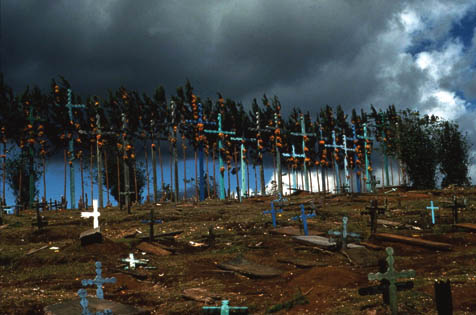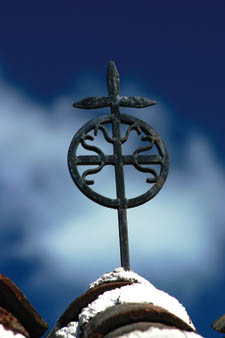Forged in Iron: The Expressive Art of the Roof Cross Tradition in Chiapas, Mexico.
At Casa de la Guerra Historic House Museum. Shows through November 11.

It is one thing to bless a house by moving one’s hands through the air, making the sign of the cross to protect it from disaster. It is another thing to make the sign of the cross visible and permanent, forged in iron and displayed on the rooftop for all to see. This shift is precisely what happened in San Crist³bal de Las Casas, Mexico, in the late-18th century. Forged in Iron: The Expressive Art of the Roof Cross Tradition in Chiapas, Mexico, an exhibition now at Casa de la Guerra, demonstrates what happens when blessings, both religious and civic, become visible.

The iron crosses seem perfectly at home on the white walls of the relatively intimate rooms of Casa de la Guerra, and the show is an attractive one. It is also educational. You might think there’s only so much a person can do with iron when the task is to make a cross to decorate the roof of a house, but this exhibition swiftly proves you wrong. With more than 20 exquisitely crafted examples spanning 100 years, Forged in Iron demonstrates the various styles and iconographies the cross takes on as it shifts from folk art to tourist art to decorative art. The exhibition’s wall labels are particularly helpful at showing the viewer the important differences between the works in terms of composition, construction, and iconography. My particular favorite was one of the baroque passion crosses made by Guadalupe Hermosillo Escobar, replete with instruments of the passion, birds, and decorative motifs, but there were also examples to appeal to those with more austere taste.
The real strength of the show, though, is in the way it creates multiple contexts for the pieces on display. For those interested in craft, the exhibition includes iron-working tools, pictures of the workshops, and information about how the artisans were trained during different periods. The exhibition also demonstrates how form followed function as the crosses began to be made not for rooftops but for display on walls.
For those who like to interpret art through ethnography, the show includes pictures of the crosses as they originally appeared on rooftops in Chiapas, and information on how the styles changed in response to the expanding market for tourist goods. Those interested in symbolism will find cultural comparisons of the meaning of the cross in European and North American cultures, and analyses of the visual references in each cross. Maybe we’ve gotten used to such rich interpretive material appearing everywhere we go. Somehow, Casa de la Guerra has made this kind of blessing new-and worth appreciating-all over again.



